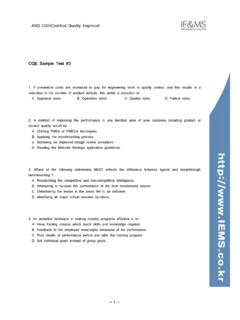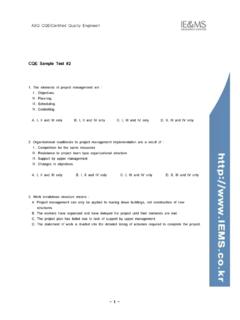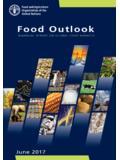Transcription of Ch.3 Demand Forecasting. - IEMS
1 Part 3 : Acquisition & Production Support. Demand forecasting . Edited by Dr. Seung Hyun Lee ( , CPL). IEMS Research Center, E-mail : Demand forecasting . [Other Resource]. Definition. An estimate of future Demand . A forecast can be determined by mathematical means using historical, it can be created subjectively by using estimates from informal sources, or it can represent a combination of both techniques. - 2 - Demand forecasting . [Other Resource]. Why forecast ? To plan for the future by reducing uncertainty. To anticipate and manage change. To increase communication and integration of planning teams. To anticipate inventory and capacity demands and manage lead times. To project costs of operations into budgeting processes. To improve competitiveness and productivity through decreased costs and improved delivery and responsiveness to customer needs. - 3 - Demand forecasting . [Other Resource]. Demand forecasting System. Constructing Demand forecasting System. 1. Determine the information that needs to be forecasted.
2 This includes defining the source of the historical data to be provided and the periods over which the data will be collected. 2. Assign responsibility for the forecast to a person which performance will be measured on the accuracy of actual sales to the forecast . 3. Setup forecast system parameters : forecast horizon. forecast level : Business unit, Product family, Model and brand, or SKU. forecast period and frequency. forecast revision : The way in which changes to the forecast will be recorded, such as original forecast , revised forecast , subsequently revised forecast , current forecast . - 4 - Demand forecasting . [Other Resource]. Demand forecasting System. Constructing Demand forecasting System. 4. Select appropriate forecasting models and techniques. 5. Collect data for input to forecasting models and test models for forecast accuracy. 6. Run the forecasting model and generating forecasts. 7. Record actual Demand information against forecast . 8. Report forecast accuracy and determine the root cause for variance between forecast and actual data.
3 Periodically assess the forecast system for performance, so that changes can be made to the forecasting approach where necessary. - 5 - Demand forecasting . [Other Resource]. General Methods of forecasting . Qualitative Techniques. They are based on expert or informed opinion regarding future product demands. This information is intuitive and based on subjective judgment. Qualitative techniques include gathering information from customer focus groups, groups of experts, think tanks, research groups, etc. - 6 - Demand forecasting . [Other Resource]. Time Series Analysis. Time series analysis is based on the idea that data relating to past Demand can be used to predict future Demand . Past data may include several components, such as trend, seasonal, or cyclical influences - 7 - Demand forecasting . [Other Resource]. Causal forecasting . Causal forecasting assumes that Demand is related to some underlying factor for factors in the environment. Causal forecasting methods develop forecasts after establishing and measuring an association between the dependent variable and one or more independent variables.
4 - 8 - Qualitative forecasting Methods. [Other Resource]. Various forecasting Methods. Qualitative Methods. Market Research. Market research is used mostly for product research in the sense of looking for new product ideas, like and dislikes about existing products, which competitive products within a particular class are preferred, and so on. Panel Consensus. In a panel consensus, the idea that two heads are better than one is extrapolated to the idea that a panel of people from a variety of positions can develop a more reliable forecast that a narrow group. Panel forecasts are developed through open meetings with free exchange of idea from all levels of management and individuals. - 9 - Qualitative forecasting Methods. [Other Resource]. Various forecasting Methods. Qualitative Methods. Historical Analogy. In trying to forecast Demand for a new product, an ideal situation would be where an existing product or generic product could be used as a model. There are many ways to classify such analogies - for example, complementary products, substitute or competitive products, and products as a function of income.
5 Delphi Method. The Delphi method conceals the identity of the individuals participating in the forecasting . Everyone has the same weight. Procedurally, a moderate creates a questionnaire and distributes it to participants. Their response are summed and given back to the entire group along with a new set of questions. - 10 - Quantitative forecasting Methods. [Other Resource]. Various forecasting Methods. Quantitative Methods : Regression. A method of fitting an equation to a data set. Simple regression involves one independent variable and one dependent variable. Least squares is the most common method of regression. - 11 - Quantitative forecasting Methods. [Other Resource]. Various forecasting Methods. Quantitative Methods : Regression. y i = a + bx i + e i where y i is the dependent variable.. x i is the independent variable, and . e i is the residual ; the error in the fit of the model. n n n b =. n x iy i - x i i=1 (. )( y ). i=1 i=1. 2. i =. S xy n n S xx n x -( x ). 2. i i i=1 i=1.
6 N n y i - b i . i=1 =1. xi a = = y-bx n - 12 - Quantitative forecasting Methods. [Other Resource]. Various forecasting Methods. Quantitative Methods : Moving Average. An arithmetic average of a certain number n of the most recent observations. As each new observation is added, the oldest observation is dropped. The value of n (the number of periods to use for the average) reflects responsiveness versus stability in the same way that the choice of smoothing constant does in exponential smoothing. Example. Demand over the past three months has been 120, 135, and 114 units. using a three-moving average, calculate the forecast for the fourth month. 120 + 135 + 114 369. forecast for month 4 = = = 123. 3 3. - 13 - Quantitative forecasting Methods. [Other Resource]. Various forecasting Methods. Quantitative Methods : Moving Average. - 14 - Quantitative forecasting Methods. [Other Resource]. Quantitative Techniques. Quantitative Methods : Weighted Moving Average. Whereas the simple moving average gives equal weight to each component of moving average database, a weighted moving average allows any weights to be placed on each element, providing, of course, that the sum of all weights equals 1.
7 F t = w 1A t - 1 + w 2A t - 2 + .. +w nA t - n where w i = Weight to be given to the actual occurrence for the period t-n n = Total number of periods in the forecast . n = 1, The sum of all the weight must equal 1. i= 1. - 15 - Quantitative forecasting Methods. [Other Resource]. Quantitative Techniques. Quantitative Methods : Exponential Smoothing. A type of weighted moving average forecasting techniques in which past observations are geometrically discounted according to their age. The heaviest weight is assigned to the most recent data. The techniques makes use of a smoothing constant to apply the difference between the most recent forecast and the critical sales data. Ft = A t-1 + ( 1 - ) F t-1. where Ft = New forecast . A t-1 = Latest Demand . F t-1 = Previous forecast . = Smoothing factor. (0 1). - 16 - Quantitative forecasting Methods. [Other Resource]. Quantitative Techniques. Quantitative Methods : Exponential Smoothing. - 17 - Quantitative forecasting Methods. [Other Resource].
8 Quantitative Techniques. Quantitative Methods : Exponential Smoothing. - 18 - Quantitative forecasting Methods. [Other Resource]. Quantitative Techniques. Quantitative Methods : Trend Effects in Exponential Smoothing. An upward or downward trend in data collected over a sequence of time periods causes the exponential forecast to always lad behind (be above or below) the actual occurrence. To correct the trend, smoothing constant delta ( ) can be used. The delta reduces the impact of the error that occurs between the actual and the forecast . FIT t = F t + T t F t = FIT t - 1 + ( A t - 1 - FIT t - 1 ). T t = T t - 1 + ( F t - FIT t - 1 ). where T t = The exponential smoothed trend for period t. where FIT t = The forecast including trend for period t. - 19 - Quantitative forecasting Methods. [Other Resource]. Quantitative Techniques. Quantitative Methods : Trend Effects in Exponential Smoothing. Example : Assume an initial starting F t of 100 units, a trend of 10 units, an alpha of , and a delta of If actual Demand turned out to be 115 rather than the forecast 100, calculated the forecast for the next period.
9 Sol). FIT t - 1 = F t - 1 +T t - 1 = 100 +10 = 110. F t = FIT t - 1 + (A t - 1 - FIT t - 1) = 110 + (115 -110) = T t = T t - 1 + (F t -FIT t - 1) = 10 + (111-110) = FIT t = F t + T t = + = - 20 - Quantitative forecasting Methods. [Other Resource]. Quantitative Techniques. Quantitative Methods : Box and Jenkins Methods. A forecasting approach based on regression and moving average models, where the model is based not regression of independent variables, but on past observation of the item to be forecast , at varying time lags, and on previous error values from forecasting . - 21 - Quantitative forecasting Methods. [Other Resource]. Decomposition of a Time Series. Decomposition. A time series can be defined as chronologically ordered data that may contain one or more components of Demand : trend, seasonal, cyclical, autocorrelation, and random. Decomposition of a time series means identifying and separating the time series data into these components. Two types of variation : Additive and Multiplicative.
10 1. Additive Seasonal Variation. forecasting including trend and seasonal = Trend + Seasonal. 2. Multiplicative Seasonal Variation. forecasting including trend and seasonal = Trend Seasonal. - 22 - Seasonality. [Other Resource]. Decomposition of a Time Series. Seasonal Index. This index is an estimate of how much the Demand during the season will be above or below the average Demand for the product. The form for the seasonality index : Period average Demand Seasonal Index =. Average Demand for all periods - 23 - Seasonality. [Other Resource]. Decomposition of a Time Series. Seasonal Index. Example : Seasonal Series Quarter Year 1 2 3 4 Total 1 122 108 81 90 401. 2 130 100 73 96 399. 3 132 98 71 99 400. Average 128 102 75 95 400. Average quarterly Demand = 100 units. Calculating seasonal index. 1. Seasonal Index for Quarter 1 = 128/100 = 2. Seasonal Index for Quarter 2 = 102/100 = 3. Seasonal Index for Quarter 3 = 75/100 = 4. Seasonal Index for Quarter 4 = 95/100 = - 24 - Causal Relationship of forecasting .










